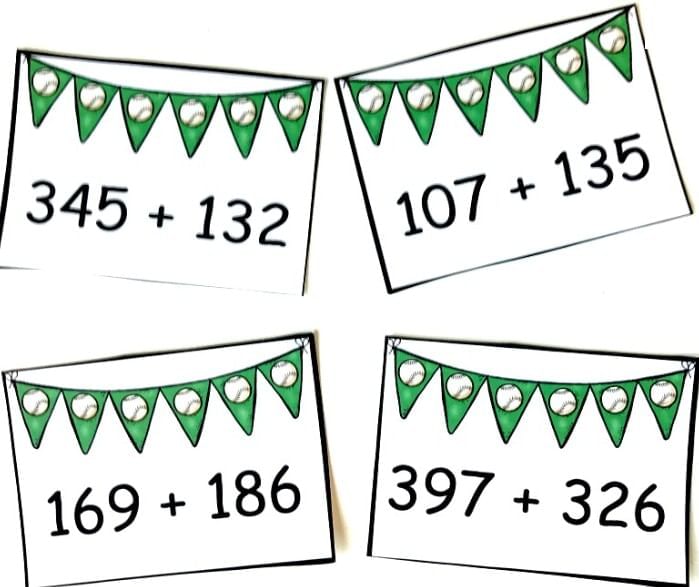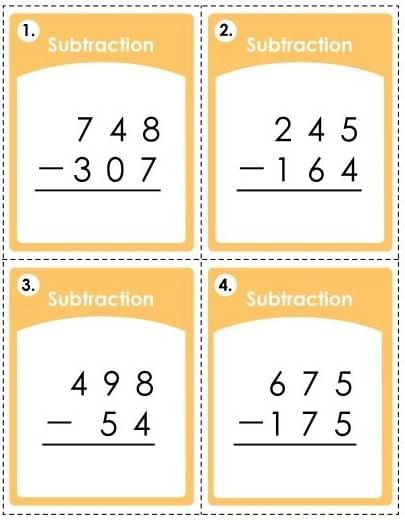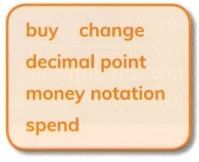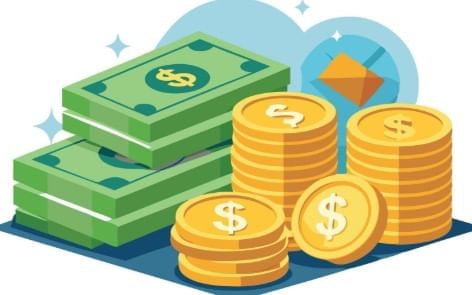Class 3 Exam > Class 3 Notes > Year 3 Mathematics IGCSE (Cambridge) > Chapter Notes: Addition, Subtraction and Money
Addition, Subtraction and Money Chapter Notes | Year 3 Mathematics IGCSE (Cambridge) - Class 3 PDF Download
| Table of contents |

|
| Introduction |

|
| Addition |

|
| Subtraction |

|
| Money |

|
Introduction
In this chapter, we learn how to add and subtract larger numbers and how to work with money. We practise regrouping when adding or subtracting, estimating answers, and solving problems in real-life situations. We also learn how to use decimals for money and calculate change when buying things.
Addition
- Add a 3-digit number and a single-digit number, regrouping the ones when necessary.
- Estimate and add a 3-digit number and a 2-digit number, regrouping the ones.
- Estimate and add two 3-digit numbers, regrouping the ones.
- Know how to regroup (exchange) when there are too many ones for the ones place.

Practise addition by:
- Choosing numbers from jars and adding them.
- Reading across or down a grid to form 3-digit numbers and adding a single-digit number to them.
- Solving word problems, e.g. number of people visiting a library or museum.
- Estimating first by rounding to the nearest ten, then adding accurately.
- Applying addition to real-life problems, such as books in a library or cakes baked by a baker.
Kiko spilled ink on the ones digits of her calculation: 24 + 13 = 381. Think of possible calculations that could give this result. Find all possible solutions and compare them with other learners. Reflect on how to investigate a similar problem next time.
- I can add a 3-digit number and a single-digit number, regrouping the ones.
- I can estimate and add a 3-digit number and a 2-digit number, regrouping the ones.
- I can estimate and add two 3-digit numbers, regrouping the ones.
Subtraction
Subtract a single-digit number from a 3-digit number, regrouping when not enough ones are available.

- Estimate and subtract a 2-digit number from a 3-digit number, regrouping when necessary.
- Estimate and subtract a 3-digit number from a 3-digit number, regrouping when necessary.
- Practise subtraction by:
- Making 2-digit and 1-digit numbers from given digits, then subtracting.
- Making 3-digit and 1-digit numbers and subtracting, showing all possible results.
- Solving real-life problems such as damaged milk cartons or melons delivered to a store.
- Finding out how many parcels are left at the post office after some are taken by vans.
- Estimating first, then calculating accurately.
Faisal spilled ink on the ones digits of his subtraction: 49 – 14 = 345. Work out possible calculations that could match this result. Compare your answers with others and discuss similarities and differences. Discuss how this kind of subtraction problem is similar or different from Kiko’s addition problem.
I can subtract a single-digit number from a 3-digit number, regrouping when needed. - I can estimate and subtract a 2-digit number from a 3-digit number, regrouping when needed.
- I can estimate and subtract a 3-digit number from another 3-digit number, regrouping when needed.
Money
Understand how to use the decimal point to show dollars and cents in the same amount.


- Learn that the dollar part is written before the decimal point, and the cents part after.
- Add amounts of money to find the total spent.
- Subtract amounts of money to find the change after spending.
- Be careful to include the dollar sign ($) and to understand that $5 – 5c is not equal to zero.
- Worked example: $4 and 24 cents is written as $4.24.
The document Addition, Subtraction and Money Chapter Notes | Year 3 Mathematics IGCSE (Cambridge) - Class 3 is a part of the Class 3 Course Year 3 Mathematics IGCSE (Cambridge).
All you need of Class 3 at this link: Class 3
|
65 docs|19 tests
|
FAQs on Addition, Subtraction and Money Chapter Notes - Year 3 Mathematics IGCSE (Cambridge) - Class 3
| 1. What is the importance of learning addition and subtraction in Class 3? |  |
Ans. Learning addition and subtraction in Class 3 is crucial as it forms the foundation for all future mathematics. These basic operations help students develop problem-solving skills, understand numerical relationships, and build confidence in their mathematical abilities. Mastery of these concepts is essential for more complex topics such as multiplication, division, and fractions.
| 2. How can students practice addition and subtraction effectively at home? |  |
Ans. Students can practice addition and subtraction at home through various engaging methods. They can use everyday items like fruits or toys for hands-on counting. Worksheets and online games designed for Class 3 students can also make practice enjoyable. Additionally, parents can encourage children to solve simple math problems during routine activities, such as calculating the total cost while shopping.
| 3. What are some common strategies for solving addition and subtraction problems? |  |
Ans. Common strategies for solving addition and subtraction problems include using number lines, counting on or back, breaking numbers into parts (such as using tens and ones), and drawing pictures to visualize the problem. These methods help students understand the concepts better and find solutions more easily.
| 4. Why is it important to understand money concepts in relation to addition and subtraction? |  |
Ans. Understanding money concepts in relation to addition and subtraction is important because it helps students apply mathematical skills to real-life situations. Learning how to add and subtract money enables students to manage budgets, make purchases, and understand the value of money. This practical knowledge is essential for their daily lives and future financial literacy.
| 5. What are some fun activities to teach children about money, addition, and subtraction? |  |
Ans. Fun activities to teach children about money, addition, and subtraction include setting up a mock store where children can "buy" and "sell" items using play money. Games like board games that involve money transactions, or online simulations that allow children to manage virtual money, can also be effective. Additionally, parents can incorporate math challenges related to their favorite activities, such as cooking or shopping, to make learning engaging.
Related Searches














